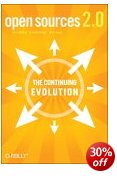essays and reports from the free software movement
When we reviewed Open Sources: Voices from the Open Source Revolution six years ago, the movement for free software was only just gathering momentum – and O’Reilly were publishing a collection of essays which were essentially explaining its key concepts. Now this second collection is symbolically twice as big, and reporting on a worldwide uptake.
 The first part of the book deals with the technical and business aspects of open sources. There’s a report on the development of Mozilla.org, which produced the Firefox browser and Thunderbird email program, and an account of working on Samba, which acts as a ‘glue’ between the separate worlds of Unix and Windows. All of these Open Source programs are available at SourceForge.net – 100.000 projects and one million registered developers.
The first part of the book deals with the technical and business aspects of open sources. There’s a report on the development of Mozilla.org, which produced the Firefox browser and Thunderbird email program, and an account of working on Samba, which acts as a ‘glue’ between the separate worlds of Unix and Windows. All of these Open Source programs are available at SourceForge.net – 100.000 projects and one million registered developers.
The amazing thing is that some people are able to develop business models using open source software. They do this by offering services which provide consultancy and support to users of open source. Michael Olson even describes a dual license system whereby the software is provided free to one set of users, and is sold at a charge to another. This essay also includes a very useful explanation of copyright law and warrantees.
The first half of the book deals with these conundrums and apparent contradictions introduced into the world of software and IT. What happens when people decide to make their software freely available to download at no charge to the end user?
There’s a very enjoyable chapter by Russ Nelson on developing his own small business enterprise dealing with open source. This will be music to the ears of anyone who would like to make a living writing and selling software and their related services.
There are fully detailed surveys of the development of open source software in Europe, India, and even China. In Europe there is a growing pattern of local and regional government adopting OSS for both political and financial reasons. In India takeup of OSS is slower because of rampant piracy of proprietary software. Piracy exists in China too, but the potential for growth in country which actually manufactures a lot of the world’s digital hardware is so great that OSS support companies are moving in to be part of the booming economy.
The second part of the book looks ‘beyond’ open sources as a technology to the philosophy of what’s at its base – collaborative forms of working. These chapters examine new business models, such as Amazon for instance which operates using open source software, but also invites collaborative input from its customers and even its competitors. Other examples include open source legal researching and even biology.
There’s a very interesting contribution from Larry Sanger on the history of the Wikipedia project – the open source encyclopedia of which he was a co-founder. Some of the problems raised in keeping Wikipedia free of vandals is answered in a similar account of the rise and rise of Slashdot.org (“News for nerds. Stuff that matters”) the socio-technological news site which permits submissions and comments in an open source sort of way. It has developed a form of hands-off self-monitoring system which welds people together into a community.
This book is as important and impressive as its predecessor. It offers updates on practical examples of the social and technological innovations of the late twentieth century and gives us a glimpse of what might become working models for what lies ahead in the twenty-first.
© Roy Johnson 2005
Chris DiBona et al, Open Sources 2.0, Sebastopol: CA, O’Reilly, 2005, pp.445, ISBN: 0596008023
More on eCommerce
More on media
More on publishing
More on technology